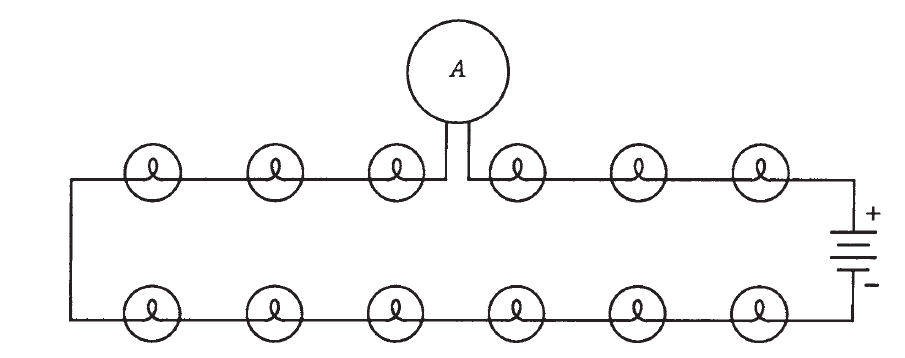
Current through series resistances
 المؤلف:
Stan Gibilisco
المؤلف:
Stan Gibilisco
 المصدر:
Teach Yourself Electricity and Electronics
المصدر:
Teach Yourself Electricity and Electronics
 الجزء والصفحة:
82
الجزء والصفحة:
82
 11-4-2021
11-4-2021
 2326
2326
Current through series resistances
Have you ever used those tiny holiday lights that come in strings? If one bulb burns out, the whole set of bulbs goes dark; then you have to find out which bulb is bad, and replace it to get the lights working again. Each bulb works with something like 10 V; there are about a dozen bulbs in the string. You plug in the whole bunch and the 120-V utility mains drive just the right amount of current through each bulb.
In a series circuit, such as a string of light bulbs (Fig. 1), the current at any given point is the same as the current at any other point. The ammeter, A, is shown in the line between two of the bulbs. If it were moved anywhere else along the current path, it would indicate the same current. This is true in any series dc circuit, no matter what the components actually are and regardless of whether or not they all have the same resistance.
If the bulbs in Fig. 1 were of different resistances, some of them would consume more power than others. In case one of the bulbs in Fig. 1 burns out, and its socket is then shorted out instead of filled with a replacement bulb, the current through the whole chain will increase, because the overall resistance of the string would go down. This would force each of the remaining bulbs to carry too much current. Another bulb would probably burn out before long. If it, too, were replaced with a short circuit, the current

Fig. 1: Light bulbs in series. An ammeter, A is placed in the circuit to measure current.
would be increased still further. A third bulb would probably blow out almost right away after the string was plugged in.
 الاكثر قراءة في الألكترونيات
الاكثر قراءة في الألكترونيات
 اخر الاخبار
اخر الاخبار
اخبار العتبة العباسية المقدسة


